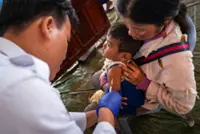Use just enough insect repellent to cover your child’s exposed skin and clothing – using more won’t make it more effective. — TNS
Warmer weather means more chances for kids to go outside to play, hike and enjoy the fresh air with family and friends.
Going outside also means preventing insect bites.
Already a subscriber? Log in
Save 30% OFF The Star Digital Access
Cancel anytime. Ad-free. Unlimited access with perks.




